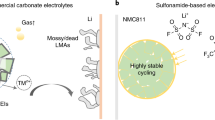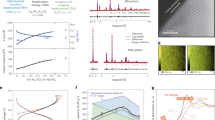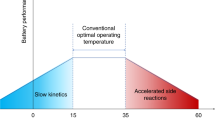Abstract
Next-generation lithium-battery cathodes often involve the growth of lithium-rich phases, which enable specific capacities that are 2−3 times higher than insertion cathode materials, such as lithium cobalt oxide. Here, we investigated battery chemistry previously deemed irreversible in which lithium oxide, a lithium-rich phase, grows through the reduction of the nitrate anion in a lithium nitrate-based molten salt at 150 °C. Using a suite of independent characterization techniques, we demonstrated that a Ni nanoparticle catalyst enables the reversible growth and dissolution of micrometre-sized lithium oxide crystals through the effective catalysis of nitrate reduction and nitrite oxidation, which results in high cathode areal capacities (~12 mAh cm–2). These results enable a rechargeable battery system that has a full-cell theoretical specific energy of 1,579 Wh kg–1, in which a molten nitrate salt serves as both an active material and the electrolyte.
This is a preview of subscription content, access via your institution
Access options
Access Nature and 54 other Nature Portfolio journals
Get Nature+, our best-value online-access subscription
$29.99 / 30 days
cancel any time
Subscribe to this journal
Receive 12 print issues and online access
$259.00 per year
only $21.58 per issue
Buy this article
- Purchase on Springer Link
- Instant access to full article PDF
Prices may be subject to local taxes which are calculated during checkout




Similar content being viewed by others
Data availability
The data that support the plots within this paper and other findings of this study are available from the corresponding authors upon reasonable request.
References
Armand, M. & Tarascon, J. M. Building better batteries. Nature 451, 652–657 (2008).
McCloskey, B. D., Burke, C. M., Nichols, J. E. & Renfrew, S. E. Mechanistic insights for the development of Li–O2 battery materials: addressing Li2O2 conductivity limitations and electrolyte and cathode instabilities. Chem. Commun. 51, 12701–12715 (2015).
Abraham, K. M. & Jiang, Z. A polymer electrolyte-based rechargeable lithium/oxygen battery. J. Electrochem. Soc. 143, 1–5 (1996).
Aurbach, D., McCloskey, B. D., Nazar, L. F. & Bruce, P. G. Advances in understanding mechanisms underpinning lithium–air batteries. Nat. Energy 1, 1–11 (2016).
Yamin, H. & Peled, E. Electrochemistry of a nonaqueous lithium/sulfur cell. J. Power Sources 9, 281–287 (1983).
Pang, Q., Liang, X., Kwok, C. Y. & Nazar, L. F. Advances in lithium–sulfur batteries based on multifunctional cathodes and electrolytes. Nat. Energy 1, 1–11 (2016).
Raistrick, I. D., Poris, J. & Huggins, R. A. in Proc. Symposium on Lithium Batteries Vol. 81(4) (ed. Venkatssety, H. V.) 477–483 (The Electrochemical Society, 1981).
Miles, M. H. Cation effects on the electrode reduction of molten nitrates. J. Electrochem. Soc. 127, 1761–1766 (1980).
Desimoni, E., Palmisano, F. & Zambonin, P. G. Catalytic currents in fused salts: discharge mechanism of nitrite in molten alkali nitrates. J. Electroanal. Chem. 84, 315–322 (1977).
Huggins, R. Advanced Batteries: Materials Science Aspects (Springer Science & Business Media, 2008).
Addison, D. D. et al. Rechargeable batteries employing catalyzed molten nitrate positive electrodes. US patent 2016/0204418 A1 (2016).
Seriani, N. Ab initio thermodynamics of lithium oxides: from bulk phases to nanoparticles. Nanotechnology 20, 445703 (2009).
Giordani, V. et al. A molten salt lithium–oxygen battery. J. Am. Chem. Soc. 138, 2656–2663 (2016).
Xia, C. et al. A high-energy-density lithium–oxygen battery based on a reversible four-electron conversion to lithium oxide. Science 361, 777–781 (2018).
James, D. W. & Leong, W. H. Structure of molten nitrates. III. Vibrational spectra of LiNO3, NaNO3, and AgNO3. J. Chem. Phys. 51, 640–646 (1969).
Balasubrahmanyam, K. & Janz, G. J. Molten mixtures of AgNO3 and TlNO3: Raman spectra and structure. J. Chem. Phys. 57, 4089–4091 (1972).
McCloskey, B. D., Bethune, D. S., Shelby, R. M., Girishkumar, G. & Luntz, A. C. Solvents’ critical role in nonaqueous lithium–oxygen battery electrochemistry. J. Phys. Chem. Lett. 2, 1161–1166 (2011).
McCloskey, B. D. et al. Twin problems of interfacial carbonate formation in nonaqueous Li–O2 batteries. J. Phys. Chem. Lett. 3, 997–1001 (2012).
Chiang, Y.-M., Birnie, D. P., Kingery, W. D. & Newcomb, S. Physical Ceramics: Principles for Ceramic Science and Engineering (Wiley, 1997).
Tenent, R. C. et al. Fast-switching electrochromic Li+-doped NiO films by ultrasonic spray deposition. J. Electrochem. Soc. 157, H318–H322 (2010).
Chia-Ching, W. & Cheng-Fu, Y. Investigation of the properties of nanostructured Li-doped NiO films using the modified spray pyrolysis method. Nanoscale Res. Lett. 8, 1–5 (2013).
Nguyen, Q. M. Technological status of nickel oxide cathodes in molten carbonate fuel cells—a review. J. Power Sources 24, 1–19 (1988).
Desimoni, E., Paniccia, F. & Zambonin, P. G. Solubility and detection (down to 30 p.p.b.) of oxygen in molten alkali nitrates. J. Electroanal. Chem. 38, 373–379 (1972).
Gallant, B. M. et al. Chemical and morphological changes of Li–O2 battery electrodes upon cycling. J. Phys. Chem. C 116, 20800–20805 (2012).
Freunberger, S. A. et al. Reactions in the rechargeable lithium–O2 battery with alkyl carbonate electrolytes. J. Am. Chem. Soc. 133, 8040–8047 (2011).
Kwabi, D. G. et al. Chemical instability of dimethyl sulfoxide in lithium–air batteries. J. Phys. Chem. Lett. 5, 2850–2856 (2014).
Giordani, V. et al. Efficient Rechargeable Li/O 2 Batteries Utilizing Stable Inorganic Molten Salt Electrolytes 2016 (DOE Vehicle Technologies Program Review, 2016); www.energy.gov/sites/prod/files/2016/06/f32/es233_giordani_2016_p_web.pdf
Acknowledgements
We thank C. Garland for assistance with the TEM operation, N. Dalleska and the Environmental Analysis Center of the California Institute of Technology for assistance with the ion exchange chromatography, K. Narita for assistance collecting Raman spectra and the Molecular Materials Research Center of the Beckman Institute of the California Institute of Technology for use of their XPS. This work was supported by the FY 2014 Vehicle Technologies Program Wide Funding Opportunity Announcement, under Award no. DE-FOA-0000991 (0991–1872), by the US Department of Energy (DOE) and National Energy Technology Laboratory (NETL) on behalf of the Office of Energy Efficiency and Renewable Energy (EERE).
Author information
Authors and Affiliations
Contributions
D.A., G.V.C., V.G. and J.U. conceived the project. V.G., J.U., D.T. and H.T. collected the electrochemical data. D.T. performed the electron microscopy, diffraction and chromatography. H.T. performed the Raman spectroscopy. D.T. and B.M.G. performed the XPS. J.U. performed the ultraviolet–visible spectroscopy and synthesized Li-doped Ni oxide. B.D.M. and J.R.G. assisted with the data analysis. D.T. and V.G. wrote the manuscript with input from all the authors.
Corresponding authors
Ethics declarations
Competing interests
D.A., G.V.C., V.G. and J.U. are inventors on US patent application 2016/0204418.
Additional information
Publisher’s note Springer Nature remains neutral with regard to jurisdictional claims in published maps and institutional affiliations.
Supplementary information
Supplementary information
Supplementary Figs. 1–12, Supplementary Table 1 and Supplementary Characterization.
Rights and permissions
About this article
Cite this article
Giordani, V., Tozier, D., Uddin, J. et al. Rechargeable-battery chemistry based on lithium oxide growth through nitrate anion redox. Nat. Chem. 11, 1133–1138 (2019). https://doi.org/10.1038/s41557-019-0342-6
Received:
Accepted:
Published:
Issue Date:
DOI: https://doi.org/10.1038/s41557-019-0342-6
This article is cited by
-
Advances in the chemistry and applications of alkali-metal–gas batteries
Nature Reviews Chemistry (2020)
-
Sustained-Release Nanocapsules Enable Long-Lasting Stabilization of Li Anode for Practical Li-Metal Batteries
Nano-Micro Letters (2020)



